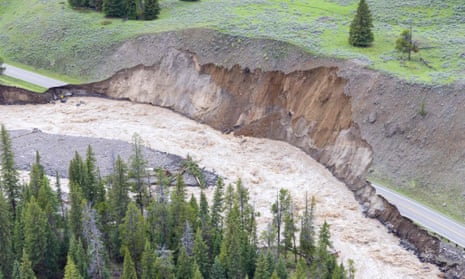The forces of fire and ice shaped Yellowstone national park over thousands of years. It took decades longer for humans to tame it enough for tourists to visit, often from the comfort of their cars.
In just days, heavy rain and rapid snowmelt caused a dramatic flood that may forever alter the human footprint on the park’s terrain and the communities that have grown around it.
The historic floodwaters that raged through Yellowstone this week, tearing out bridges and pouring into nearby homes, pushed a popular fishing river off course possibly permanently and may force roadways nearly torn away by torrents of water to be rebuilt in new places.
“The landscape literally and figuratively has changed dramatically in the last 36 hours,” said Bill Berg, a commissioner in nearby Park county. “A little bit ironic that this spectacular landscape was created by violent geologic and hydrologic events, and it’s just not very handy when it happens while we’re all here settled on it.”
The unprecedented flooding drove more than 10,000 visitors out of the nation’s oldest national park and damaged hundreds of homes in nearby communities, though remarkably no was reported hurt or killed. The only visitors left in the massive park straddling three states were a dozen campers still making their way out of the backcountry.
The park could remain closed as long as a week, and northern entrances may not reopen this summer, Superintendent Cam Sholly said.
“I’ve heard this is a 1,000-year event, whatever that means these days. They seem to be happening more and more frequently,” he said.
Sholly noted some weather forecasts include the possibility of additional flooding this weekend.
Days of rain and rapid snowmelt wrought havoc across parts of southern Montana and northern Wyoming, where it washed away cabins, swamped small towns and knocked out power. It hit the park as a summer tourist season that draws millions of visitors was ramping up during its 150th anniversary year.
Businesses in hard-hit Gardiner had just started really recovering from the tourism contraction brought by the coronavirus pandemic, and were hoping for a good year, Berg said.
“It’s a Yellowstone town, and it lives and dies by tourism, and this is going to be a pretty big hit,” he said. “They’re looking to try to figure out how to hold things together.”
Some of the worst damage happened in the northern part of the park and Yellowstone’s gateway communities in southern Montana. National Park Service photos of northern Yellowstone showed a mudslide, washed out bridges and roads undercut by churning floodwaters of the Gardner and Lamar rivers.
In Red Lodge, a town of 2,100 that’s a popular jumping-off point for a scenic route into the Yellowstone high country, a creek running through town jumped its banks and swamped the main thoroughfare, leaving trout swimming in the street a day later under sunny skies.
